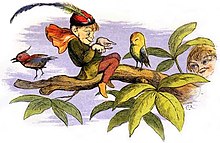Signs and symptoms
The most common symptoms of Williams syndrome are mental disability, heart defects, and unusual facial features. Other symptoms include failure to gain weight appropriately in infancy and low muscle tone. Most individuals with Williams syndrome are highly verbal and overly sociable, having what has been described as a "cocktail party" type personality, and exhibit a remarkable blend of cognitive strengths and weaknesses.[3] Individuals with WS hyperfocus on the eyes of others in social engagements.[4] Patients tend to have widely spaced teeth, a long philtrum, and flattened nasal bridge.[5] Individuals with Williams syndrome also experience many cardiac problems, commonly heart murmurs and the narrowing of major blood vessels as well as supravalvular aortic stenosis. Other symptoms may include gastrointestinal problems, such as severe or prolonged colic,[6] abdominal pain and diverticulitis, nocturnal enuresis (bed wetting) and urinary difficulties,[7] dental irregularities and defective tooth enamel,[8] as well as hormone problems, the most common being hypercalcemia (elevated calcium levels in the blood). Hypothyroidism has been reported to occur in children, although there is no proof of it occurring in adults; diabetes has been reported to occur in adults with WS as young as 21 years old.[9]
Individuals with Williams syndrome often have hyperacusis and phonophobia which resembles noise-induced hearing loss, but this may be due to a malfunctioning auditory nerve.[10][11] However, individuals with WS can also tend to demonstrate a love of music,[2] and appear significantly more likely to possess perfect pitch.[12] There also appears to be a higher prevalence of left-handedness and left-eye dominance.[13] Individuals with Williams syndrome also report higher anxiety levels as well as phobiadevelopment, which may be associated with hyperacusis.[14]
Furthermore, individuals with Williams syndrome have problems with visual processing, but this is related to difficulty in dealing with complex spatial relationships rather than to issues with depth perception.[15]
In an experiment, a group of children with Williams syndrome showed no signs of inherent racial bias, unlike children without the syndrome.[16]
While patients with Williams syndrome often have abnormal proficiency in verbal skills, they do not perform better on verbal tasks than average. This syndrome is characterized more by a deficiency in other areas of processing. Williams syndrome is notable in that respect in that it represents a double dissociation between verbal and spatial processing.
Some cultural historians believe that the adjective "elfin" came to be used to describe the facial features of people with Williams syndrome because, before Williams Syndrome's scientific cause was understood, people believed that sufferers of the syndrome, who have very charming and extraordinarily kind personalities in comparison to most people, were gifted with extraordinary, even magical, powers. This is often believed to be the origin of the folklore of elves, fairies and other forms of the 'good people' or 'wee folk' present in English folklore.[17]
News: Williams Syndrome
Trends: Williams Syndrome
Wikipedia: Williams Syndrome

No comments:
Post a Comment